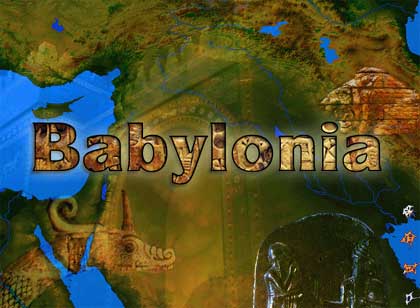Ancient Babylonia (Babylon the Great)

- Babylonia
- Introduction
- History of Babylonia
- Old Babylonian Period (2000 - 1595 BC)
- Middle Babylonian Period (1595 - 1000 BC)
- Neo Babylonian Period (1000 - 539 BC)
- Literature
- Religion
- Law & Justice
- King and State
- Economy & Social Structure
- Science
- Archaeology
- Biblical History
- Maps
- Timelines
"And Nebuchadnezzar of Babylon carried out from there all the treasures of the house of the LORD and the treasures of the king's house, and he cut in pieces all the articles of gold which Solomon king of Israel had made in the temple of the LORD, as the LORD had said. Also he carried into captivity all Jerusalem: all the captains and all the mighty men of valor, ten thousand captives, and all the craftsmen and smiths. None remained except the poorest people of the land."
In the cradle of civilization, along the fertile banks of the Tigris and Euphrates rivers, emerged one of the most influential and enduring empires of ancient times—Babylonia. Spanning from the 18th to the 6th century BCE, this Mesopotamian civilization left an indelible mark on history, boasting remarkable achievements in governance, culture, and engineering. This post delves into the fascinating journey of Ancient Babylonia, from its humble beginnings to its eventual decline.
- The Rise of Babylonia:
- Hammurabi and the First Babylonian Dynasty:
- The city of Babylon rises to prominence under the rule of Hammurabi (1792–1750 BCE).
- Hammurabi's Code, one of the earliest legal codes, establishes justice and governance principles.
- Babylon becomes a cultural and economic hub in Mesopotamia.
- Babylon as the Epicenter of Trade and Learning:
- The Hanging Gardens of Babylon, one of the Seven Wonders of the Ancient World.
- Babylonian achievements in astronomy, mathematics, and literature, including the Epic of Gilgamesh.
- Hammurabi and the First Babylonian Dynasty:
- The Zenith of Babylonia:
- Nebuchadnezzar II and the Neo-Babylonian Empire:
- Nebuchadnezzar II (605–562 BCE) expands Babylonia's borders and solidifies its power.
- Architectural marvels such as the Ishtar Gate and the reconstruction of the city.
- Babylon as a Center of Wisdom:
- The Hanging Gardens and the Tower of Babel capture the imagination of later generations.
- The Babylonian Exile and the impact on the Jewish diaspora.
- Nebuchadnezzar II and the Neo-Babylonian Empire:
- The Fall of Babylonia:
- Persian Conquest and Cultural Shifts:
- Cyrus the Great conquers Babylon in 539 BCE, marking the end of the Neo-Babylonian Empire.
- The assimilation of Babylonian culture into the Persian Empire.
- Legacy and Contributions:
- Babylonia's enduring influence on art, science, and law.
- The preservation of cuneiform tablets and the decipherment of the Babylonian language.
- Persian Conquest and Cultural Shifts:
Ancient Babylonia, with its towering ziggurats and flourishing cultural achievements, stands as a testament to the resilience and creativity of humanity. From Hammurabi's Code to Nebuchadnezzar's grandeur, the rise and fall of this Mesopotamian empire shaped the course of history and left an indelible legacy that continues to captivate scholars and enthusiasts alike. The echoes of Babylonian contributions reverberate through the ages, reminding us of the rich tapestry of human civilization that unfolded along the banks of the Tigris and Euphrates.
Also see: Ancient Babylonia Map
Free Bible (www.free-bible.com)

Read The Bible
- 1599 Geneva Bible (GNV)
- 21st Century King James Version (KJ21)
- American Standard Version (ASV)
- Amplified Bible (AMP)
- Amplified Bible, Classic Edition (AMPC)
- Authorized (King James) Version (AKJV)
- BRG Bible (BRG)
- Christian Standard Bible (CSB)
- Common English Bible (CEB)
- Complete Jewish Bible (CJB)
- Contemporary English Version (CEV)
- Darby Translation (DARBY)
- Disciples’ Literal New Testament (DLNT)
- Douay-Rheims 1899 American Edition (DRA)
- Easy-to-Read Version (ERV)
- English Standard Version (ESV)
- English Standard Version Anglicised (ESVUK)
- Evangelical Heritage Version (EHV)
- Expanded Bible (EXB)
- GOD’S WORD Translation (GW)
- Good News Translation (GNT)
- Holman Christian Standard Bible (HCSB)
- International Children’s Bible (ICB)
- International Standard Version (ISV)
- J.B. Phillips New Testament (PHILLIPS)
- Jubilee Bible 2000 (JUB)
- King James Version (KJV)
- Lexham English Bible (LEB)
- Living Bible (TLB)
- Modern English Version (MEV)
- Mounce Reverse Interlinear New Testament (MOUNCE)
- Names of God Bible (NOG)
- New American Bible (Revised Edition) (NABRE)
- New American Standard Bible (NASB)
- New American Standard Bible 1995 (NASB1995)
- New Catholic Bible (NCB)
- New Century Version (NCV)
- New English Translation (NET)
- New International Reader's Version (NIRV)
- New International Version - UK (NIVUK)
- New International Version (NIV)
- New King James Version (NKJV)
- New Life Version (NLV)
- New Living Translation (NLT)
- New Matthew Bible (NMB)
- New Revised Standard Version (NRSV)
- New Revised Standard Version Catholic Edition (NRSVCE)
- New Revised Standard Version, Anglicised (NRSVA)
- New Revised Standard Version, Anglicised Catholic Edition (NRSVACE)
- New Testament for Everyone (NTE)
- Orthodox Jewish Bible (OJB)
- Revised Geneva Translation (RGT)
- Revised Standard Version (RSV)
- Revised Standard Version Catholic Edition (RSVCE)
- The Message (MSG)
- The Voice (VOICE)
- Tree of Life Version (TLV)
- World English Bible (WEB)
- Worldwide English (New Testament) (WE)
- Wycliffe Bible (WYC)
- Young's Literal Translation (YLT)
Table of Contents
Main Menu
- Ancient Assyrian Social Structure
- Ancient Babylonia
- Ancient Canaan During the Time of Joshua
- Ancient History Timeline
- Ancient Oil Lamps
- Antonia Fortress
- Archaeology of Ancient Assyria
- Assyria and Bible Prophecy
- Augustus Caesar
- Background Bible Study
- Bible
- Biblical Geography
- Fallen Empires - Archaeological Discoveries and the Bible
- First Century Jerusalem
- Glossary of Latin Words
- Herod Agrippa I
- Herod Antipas
- Herod the Great
- Herod's Temple
- High Priest's in New Testament Times
- Jewish Literature in New Testament Times
- Library collection
- Map of David's Kingdom
- Map of the Divided Kingdom - Israel and Judah
- Map of the Ministry of Jesus
- Matthew Henry Bible Commentary
- Messianic Prophecy
- Nero Caesar Emperor
- Online Bible Maps
- Paul's First Missionary Journey
- Paul's Second Missionary Journey
- Paul's Third Missionary Journey
- Pontius Pilate
- Questions About the Ancient World
- Tabernacle of Ancient Israel
- Tax Collectors in New Testament Times
- The Babylonian Captivity
- The Black Obelisk of Shalmaneser
- The Books of the New Testament
- The Court of the Gentiles
- The Court of the Women in the Temple
- The Destruction of Israel
- The Fall of Judah with Map
- The History Of Rome
- The Incredible Bible
- The Jewish Calendar in Ancient Hebrew History
- The Life of Jesus in Chronological Order
- The Life of Jesus in Harmony
- The Names of God
- The New Testament
- The Old Testament
- The Passion of the Christ
- The Pharisees
- The Sacred Year of Israel in New Testament Times
- The Samaritans
- The Scribes
Ancient Questions
- How did the ancient Greeks and Romans practice medicine and treat illnesses?
- What were the major contributions of ancient Babylon to mathematics and astronomy?
- How did the ancient Persians create and administer their vast empire?
- What were the cultural and artistic achievements of ancient India, particularly during the Gupta Empire?
- How did ancient civilizations like the Incas and Aztecs build their remarkable cities and structures?
- What were the major trade routes and trading practices of the ancient world?
- What was the role of slavery in ancient societies like Rome and Greece?
- How did the ancient Mayans develop their sophisticated calendar system?
- What were the key events and significance of the Battle of Thermopylae in ancient Greece?
- What was life like for women in ancient Rome?
Bible Study Questions
- What does biblical archaeologist said about hieroglyphics?
- Where is the Negev where Abram went to in Genesis?
- What is the name of Ramallah in the Bible?
- How do we approach and study the historical and cultural context of biblical passages?
- What is the significance of the Psalms in personal and corporate worship?
- How do we discern and apply biblical principles to contemporary ethical issues?
- What is the biblical perspective on the nature of God's love and mercy?
- How do we interpret and understand apocalyptic literature in the Bible?
- What are the different covenants in the Bible and their significance?
- How do we grow in spiritual maturity and develop a deeper understanding of the Word?
About
Welcome to Free Bible: Unearthing the Past, Illuminating the Present! Step into a world where ancient history and biblical narratives intertwine, inviting you to explore the rich tapestry of human civilization.
Discover the captivating stories of forgotten empires, delve into the customs and cultures of our ancestors, and witness the remarkable findings unearthed by dedicated archaeologists.
Immerse yourself in a treasure trove of knowledge, where the past comes alive and illuminates our understanding of the present.
Join us on this extraordinary journey through time, where curiosity is rewarded and ancient mysteries await your exploration.
Recent posts
-

Personalized Baby Bibs for every Little
Every little one deserves to feel cherished and celebrated from the very start. These custom baby bibs, lovingly personalized with care, make the perf... -

The Art of Custom Home Design: Unveiling Wellcore Corporation's Expertise
In the ever-evolving panorama of contemporary production, customization reigns ultimate as a testament to innovation and the preference for a without ... -

Birthstones: A Sparkling Symphony of History, Symbolism, and Self-Expression
Birthstones, the ones fascinating gems linked to our delivery month, boast a records as rich and multifaceted because the jewels themselves. Their tal... -

The use of medicinal mushrooms by different religions of the world.
The integration of medicinal mushrooms into various religious practices around the world is a fascinating testament to their revered status across cul... -

Explore a Collection of Religious SVGs
Religious SVGs are versatile design elements that can be used to create a variety of personalized and meaningful projects. Whether you're looking to e...